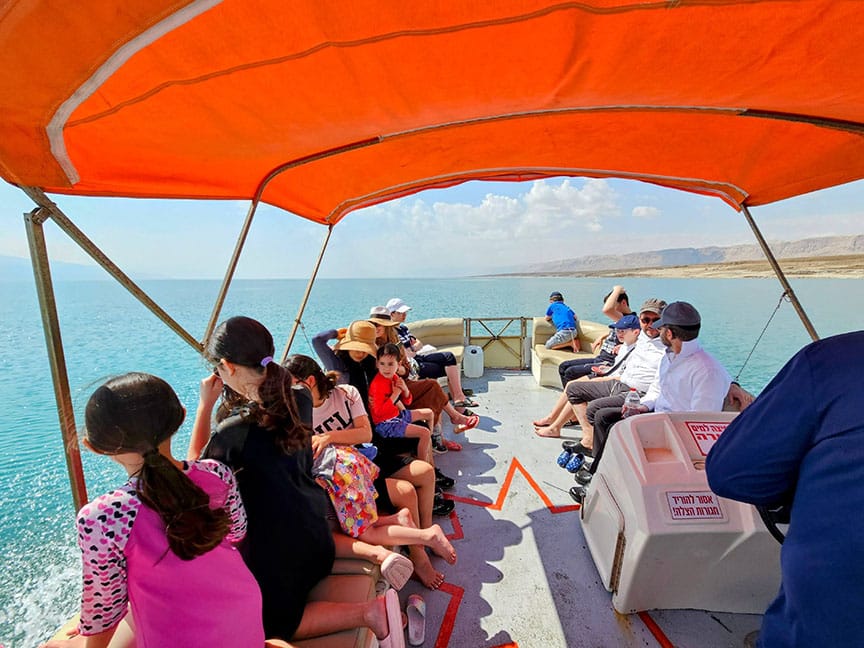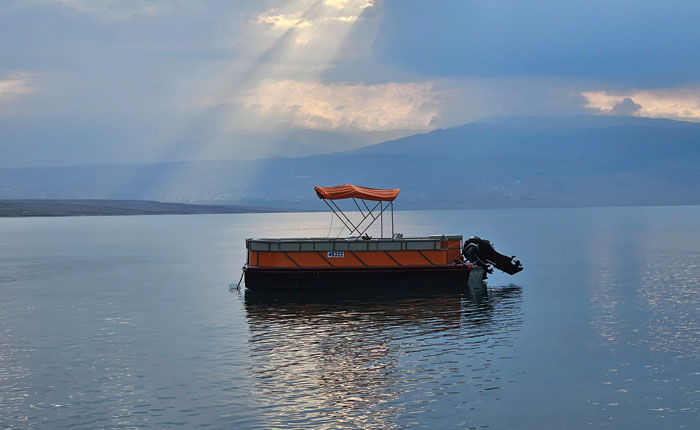“Stars” – metaphorically, of course. There were no stars out on the day I took a trip on a little boat in the Dead Sea. I recently went with my close friend and neighbor, Sara Bedein. What else should two balabustas do a week before Pesach?
Seven years ago, Noam Bedein (Sara’s son) first visited the Dead Sea on a boat and learned of the catastrophic lowering of the sea level in a sea that, according to Bedein, used to reach minus 437 meters below sea level.
He reached out to Ari Fruchter, an art collector and Dead Sea advocate, who later became the Co-founder of the Dead Sea Revival Project in 2017. Since then, they have taken thousands of people, including filmmakers and top media outlets on excursions ranging from 90-180 minutes through the Dead Sea and along the coast, where one can see, with their own eyes, the levels that the sea used to reach. At one point he showed us a small mountain and said, “See those white lines? Like the lines in the trunk of a tree, each of those lines is the year that the sea reached that level.”
In 2021, Fruchter, a Member of the Board of Governors at the Tel Aviv Museum of Art, also founded the Dead Sea Museum in Arad, which will include installations, photographs, history and an immersive iconic building overlooking the Dead Sea.
The people who joined us on the boat included tourists, journalists and Israelis, and one mom, an “olah” (new immigrant) from England, with her 9-month-old baby. Bedein looked a bit surprised when he saw her and said to me, quietly, “I didn’t know about the baby, but we’ll manage.” And then he announced on the boat that the baby was the youngest passenger ever to take a ride on this kind of boat on the Dead Sea.

We left from Neve Midbar, a gorgeous beachfront retreat in the middle of arid surroundings, that includes both a kiddie and adult fresh water pools, lush grass picnic and barbeque areas, a kosher restaurant and separate coffee and drinks bars, comfortable bathroom and shower facilities, and a gift shop where one can buy, among other things, Dead Sea cosmetic and skin care products and exotic Bedouin crafts, and of course a beachfront where one can dip in the Dead Sea itself, that is supposed to have exceptional healing qualities.
But to get to the actual shore we had to walk down about 100 steps. Bedein told us that the Dead Sea used to reach the top of those steps. It concretized for us the calamity of the sea’s retreat. Bedein and the Dead Sea Revival Project have been featured in National Geographic and CNN and recognized by NASA.
We were told in advance to wear shoes that were waterproof and clothes that we didn’t mind getting wet. Fruchter, Bedein and Amir Green, the boat’s captain, who lives in the nearby Kibbutz Kalia, helped the passengers tread through the salty water and climb onto the high motor boat.
We settled in for an exhilarating ride through the sparkling green-blue water, while Bedein gave us some current and past history.
He said that 30% of the problem of the drastic lowering of the Dead Sea is due to the factories both in Israel and Jordan that are pumping out the water, extracting the minerals for export and that 70% is due to less water flowing in from the “historic” sources, i.e. the Jordan River, the Kinneret, and their water sources from neighboring countries.
“Water is the most valuable asset in the entire region,” Bedein told us. “75% of our drinking water is desalinated from The Mediterranean Sea. which adds up to 550 million cubic meters of water. The Dead Sea needs 750 million cubic meters of water to stabilize and maintain the sea level.”
What comes first? The water-starved population of Jordan or saving a water treasure? “Water diplomacy between Israel and Jordan for saving the Dead Sea has never progressed to practical solutions,” says Bedein. “The World Bank promised ten billion dollars for the Red Sea-Dead Sea canal, but that fell through officially in 2022.”
A dedicated environmentalist, Bedein says, “Since the Abraham Accords, I have been promoting and exploring the issue of regional water-diplomacy and global conservation in the Arabian Gulf, in Africa, and recently in Asia, with the recognition and invitation of government ministries and professionals.”
Amir Green showed me a piece of material that they call “diamond salt.” He explained, “It is created from ground water sources that enter the Dead Sea and when it recedes, it leaves this kind of salt. There is another spot we may stop where you can see the squares of the ‘diamonds’ – the material of diamonds looks the same as this.” He broke off a piece for me. I took it home, washed off the mud, and now the sparkling “diamond” salt sits in a clear container on my Shabbat candlestick tray, a weekly reminder of the beauties of Israel.
Today the Dead Sea is more than minus 445 meters below sea level. The estimated drop, says Bedein, is around 1.2 meters a year, equivalent to 600 Olympic pools evaporating every day.
Today the Dead Sea is more than minus 445 meters below sea level. The estimated drop, says Bedein, is around 1.2 meters a year, equivalent to 600 Olympic pools evaporating every day.
We also saw sinkholes from afar. Bedein says that over 7000 of them are spread out on the northern Dead Sea shore, and that 700 new ones appear each year. “It means that the land is very fragile and the estimated damage cost is around $90M a year, due to the collapse of roads and agricultural fields, and resorts have closed down. That’s why 98% of the Dead Sea isn’t accessible to the public, and that’s the importance and need of the initiative that we took upon ourselves — in exploring and accessing the Dead Sea, by boat.”
When Bedein was asked where the border is, he said, “In the middle.” “But how does anyone know exactly where?” He said, “They don’t.”
Only 16 kilometers (less than 10 miles) separate its Israeli coast from the Jordanian side. When Bedein was asked where the border is, he said, “In the middle.” “But how does anyone know exactly where?” He said, “They don’t.”
In the middle of the trip, the boat “docked” (in a manner of speaking – more wading through salty water) at a low, rocky area which Bedein says is “the untouched and unexplored Einot Tsukim nature reserves shoreline” where one can see a sparkling spring of water, flowing underground, from Jerusalem and the Judean Desert. There is also an exquisite Salt Rainbow Beach, about which Bedein says, “We found this while exploring the shores south of Neve Midbar.”

When we reached the point at which the boat usually turns around and returns to the Neve Midbar shore, Bedein asked us, “What is your timeline? Do you want to see a place we haven’t been before with our new boat?” Explorers! Who could say no?
The crew then took the boat farther along the shore until we reached a place where we could look up and see a cave in the mountainside. Hanging from the top of the entrance were stalactites made of salt. Bedein explained that that was how high the sea had once reached when he first came out there seven years earlier. For the first time, he will be exposing his dramatic Dead Sea time lapse photographs in Arad Cultural Center for Earth Day 2023.
Whether you live in Israel or come as a tourist, treat yourself to this ecological and magical trip. You’ll come back with salt on your body and stars in your eyes.
And wear sunscreen.









